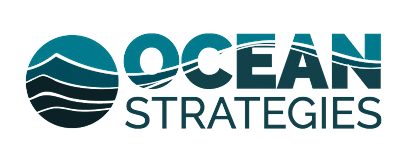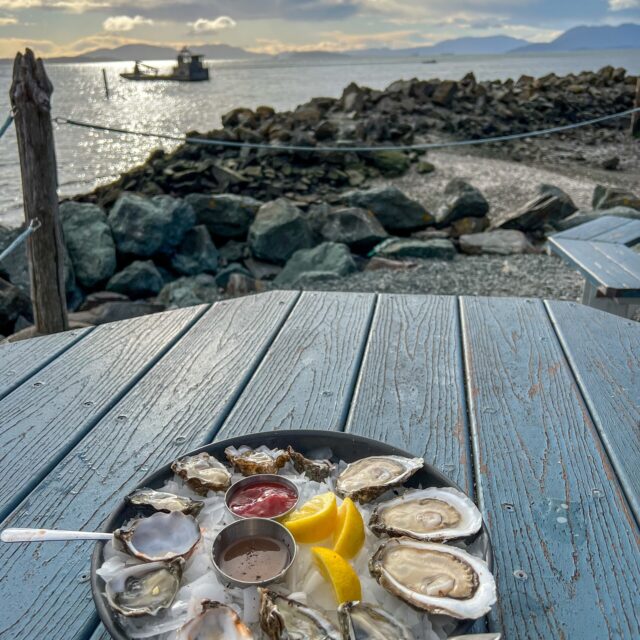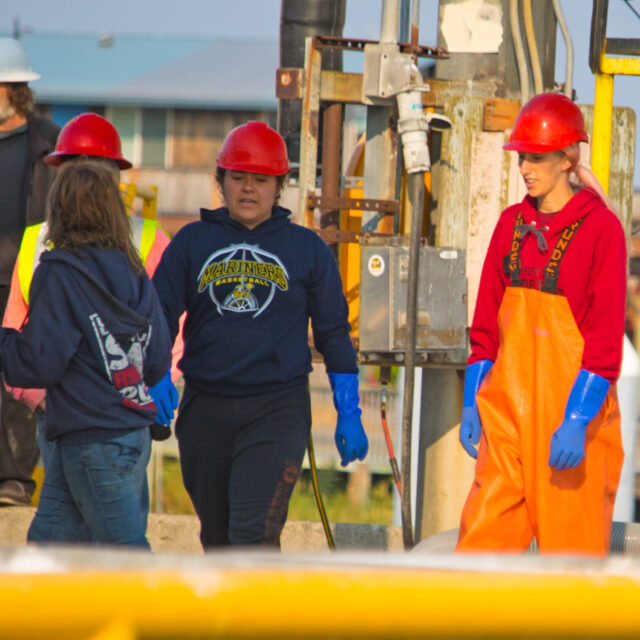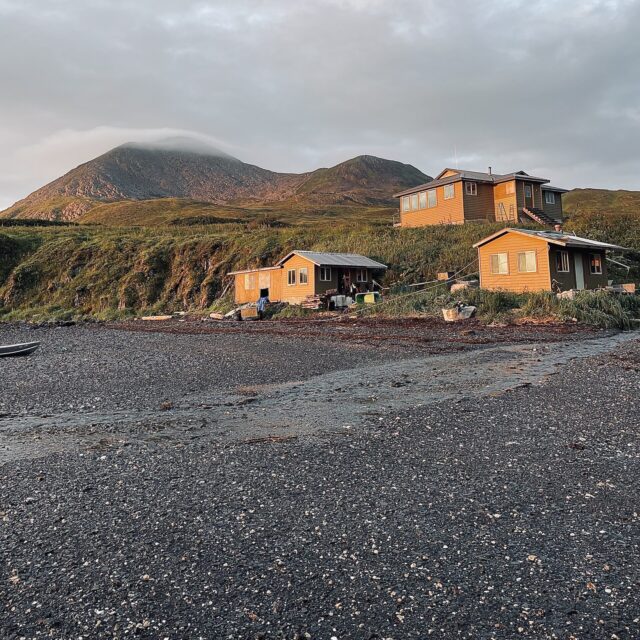Ocean Strategies recently chatted with Leigh Habegger, Executive Director of Seafood Harvesters of America, a national commercial fishing organization that works to advance science-based policies and regulations that support sustainable fisheries. Leigh discussed federal seafood-related legislation, how the commercial fishing industry has overcome Covid-19 challenges and the important role restaurants play in our seafood supply chain.
Be sure to check out the Seafood Harvesters op-ed in The Hill, “How a continuing resolution will impact the next generation of commercial fishermen,” urging Congress to fund the Young Fishermen’s Development Act.
Click the image above to watch and listen to the full interview with Leigh Habegger and Ocean Strategies Principal Brett Veerhusen.
Brett: We’re here with Leigh Habegger, Executive Director of Seafood Harvesters of America, a national commercial fishing organization representing 22 diverse regional fishing organizations from Alaska and Hawaii, to California, Texas and Maine. Seafood Harvesters works to advance science-based policies and regulations that support sustainable fisheries.
Since the pandemic, Leigh relocated to her home state of North Carolina, but spent most of her adult career in Washington, DC, where she worked for Congresswoman Chellie Pingree as a Knauss Fellow and for other marine-related organizations where she gained extensive experience in fisheries management, coastal restoration, and ocean policy. Leigh is an avid sport fisherman, and has fished all over the country, including in remote parts of Alaska and on the Gulf of Mexico’s open ocean. Her passion for recreational fishing gives credence to Leigh’s holistic understanding of marine resource management.
I’ve spent time with Leigh in Alaska, and can attest that she loves putting on her Xtra Tuffs and getting slimy on the back deck. She’s also had experience on commercial fishing boats in Rhode Island, the Gulf of Mexico and South Atlantic. I’ll also say I am lucky enough to call Leigh a very good friend. She is one of the smartest people with fisheries issues nationwide. She represents the go-to fishermen’s organization based in our nation’s capital, and she is one of the go-to resources on commercial fishing issues in the country.
Thank you very much for being here with us today, Leigh. Where are you Zooming in from and when is the next time you’re going fishing?
Leigh: Thanks, Brett. Those are some very kind words and I appreciate them. I am currently Zooming in from the bustling metropolis of North Myrtle Beach, South Carolina. I’m here for the long weekend and hopefully going to enjoy some saltwater and some sand. One of our members, Chris Conklin, owns a seafood house and fishes out of Murrells Inlet, South Carolina which is just south of where I currently am. The weather’s been a little off, it’s stormy and foggy today, but I’m hoping to get out with Chris and do some inshore fishing. I’m hoping we’ll get some sheepshead, maybe some drum. Snapper is a bit too offshore, and I don’t think the weather will allow for that.
Brett: Fun! You’ve gotta go with what the weather gives you. As commercial fishermen ourselves, we’re looking forward to getting into some fishing-related policies and issues you’ve been working on lately. But we like to start with the tough questions first – what is your favorite seafood to eat, and how do you prepare it?
Leigh: I think I’m going to have to stay true to my Southeastern roots and go with flounder. I love to cook it in a pan with a little bit of butter, garlic, lemon juice, and salt and pepper. But I’ll also say that it is hard to beat a fried flounder sandwich after a day on the boat.
When I was up in Alaska a couple years ago I had the best salmon salad of my life. I was out on a boat with one of our members, and one of their deckhands mixed up some salmon salad for lunch. It was so simple, so fresh, and just delicious. It’s hard to beat fresh Alaskan salmon. So maybe it’s a toss up between flounder and salmon!
Brett: Some of the best salmon you can have is the simplest – it’s fresh and not overly doctored up; it’s exactly what comes out of the water. So let’s get into fisheries policy and talk about the cornerstone of U.S. federal fisheries management – the Magnuson-Stevens Act. Last year Congressman Jared Huffman introduced the Sustaining America’s Fisheries for the Future Act, a bill that would reauthorize MSA. What proposed MSA updates are Seafood Harvesters tracking?
Leigh: First, I think it’s good to remember that amid all these reauthorization efforts, Magnuson is working. This legislation has resulted in significant progress for the fishing industry and for our ocean. Any changes to our overarching federal fisheries law should not undermine the strides and advancements that have already been made, thanks to MSA.
Right now, like you said, there’s ongoing debate about an MSA reauthorization proposal in the U.S. House of Representatives. It’s critically important for the fishing and seafood industry stakeholders to be aware of this discussion and to engage with their members of Congress. There is a long list of changes that Rep. Huffman is proposing. This new language could impact the seafood industry in a variety of ways. I would encourage fishermen and other folks throughout the seafood supply chain to take a look at the bill. Review the proposed changes, and if you see something that’s going to impact your operations, then get involved and provide feedback. Mr. Huffman has been very open and willing to hear from all corners of the seafood industry. It’s a great opportunity.
Brett: And it’s an opportunity to talk about the importance of seafood to your business, your operation, your livelihood – no matter where you are in the seafood supply chain. It’s a way to bring yourself to the table and inform Congress just how important seafood is to the American economy, especially in light of the positive impacts that the pandemic has had on the seafood industry. We’re experiencing record seafood sales across the supply chain. Have you seen the supply chain more engaged lately on seafood policy? Where has the industry been most active?
Leigh: We’re seeing more attention on IUU fishing and labor, trade, and H-2B visa issues. But we’ve also seen more focus from the seafood industry on telling our success story. Together with our management system, U.S. fishermen have helped lead the world in sustainability. When people ask me what seafood is safe to eat, I always tell them that if it’s U.S. caught you can feel good about it. It’s safe, it’s sustainable, period. And we’re continuing to improve on that. We’ve rebuilt more than 40 stocks and that number is increasing. We’re deploying electronic monitoring systems to improve our accountability, and we’re continuing to re-engineer our gear to address bycatch issues. We’re in this game, we have a stake in it, and we’re doing good work.
Brett: So bottom line, buying American means buying sustainable. Now, talking about the pandemic and the ways in which it has impacted policies and activity on the Hill – Seafood Harvesters of America has been leading the fishing industry nationwide by advocating for relief funds and effective policies related to Covid-19, not only for fishermen but others in the seafood supply chain. I know you were active on the Restaurants Act – restaurants being a critical component of who we supply and sell our seafood to, thus helping provide consumer access for wild-caught U.S. seafood. What are things looking like, pandemic-wise, for fisheries and the supply chain now that we’re getting closer to some busy summer fishing seasons?
Leigh: I think our operations will likely forever be changed because of Covid. Two years into the pandemic, and the fishing industry has learned to adapt. We’ve learned how to stay safe and keep our crew and people who work in processing plants safe. We’ve figured out how to get back to doing what we love, which is fishing.
The Covid relief funding that was appropriated by Congress thanks to the CARES Act and then in an appropriations bill at the end of 2022, was incredibly helpful. It allowed us to make those adaptations to our operations. This funding also helped cover our revenue losses, since demand for seafood dropped overnight. As we all know, because of this restaurants closed and people stayed at home.
On the restaurant side of things, we need our restaurants. We love them and we want them to succeed. The Restaurant Revitalization Fund is an initiative that the Independent Restaurant Coalition has been leading on. It’s an important program and was critical to helping restaurants get back on their feet. Many Americans and people around the world enjoy their seafood at restaurants. They play an important role in seafood access for many Americans and we want to make sure that they’re able to stick around for the long term.
Brett: It’s like an entry point. If you’re not comfortable making it yourself or you want to try something different then Americans turn to restaurants as a way to access new and different seafood. I believe you came out with four op-eds last year with the Independent Restaurant Coalition, urging Congress to provide those pandemic relief funds to restaurants. Did you find that partnership successful between commercial fishermen and restaurants?
Leigh: We did. We penned four op-eds, partnering with chefs in a handful of different regions – San Francisco, Alaska, New York, and Maine. I do think those op-eds resonated. There’s a natural partnership between the commercial fishing and restaurant industries. We are both trying to advocate for our needs and our asks complement each other very well.
Brett: We’ve seen that in various fishery management council policies, where chefs, restaurateurs, and restaurant trade organizations have been active in not only supporting their own interests, but recognizing that commercial fishermen having access to wild-caught seafood is their entry point to having access to to cook it and sell it. It is a great partnership and we hope to see more of it.
So shifting from the pandemic – there’s a lot of legislation moving at the federal level that could impact the seafood industry – the Build Back Better Act, 30×30 initiative, the current Aquaculture Opportunity Area process, and the Young Fishermen’s Development Act. Speaking of the Young Fishermen’s Development Act – you and the President of Seafood Harvesters just penned an op-ed in The Hill urging Congress to fund the Act, which was passed last year. We want to compliment you on that leadership and support for the next generation of commercial fishermen. Which of these policies or others does Seafood Harvesters feel are most critical to be weighing in on?
Leigh: I’ll touch on a few – First, there’s an opportunity to weigh in on the 30×30 initiative. The comment period deadline to provide input on the Marine Protected Area Atlas is March 7th. NOAA and the Department of Interior want to hear from stakeholders about what existing conservation areas, both marine and terrestrial, should be included in the Atlas as they figure out their inventory of conservation measures. Harvesters supports the existing work of the fishery councils, and the important conservation measures and protections they have already put in place. Councils need to be at the heart of this 30×30 effort. They have the expertise and institutional knowledge on fisheries management. This initiative has the potential to be good for ocean health and complement the commercial fishing industry; it doesn’t have to be one or the other.
Also, there is an ongoing opportunity for stakeholders to weigh in on the annual federal appropriations process; this is an important area to advocate for funding that would benefit the seafood industry. This is the process that Congress undertakes to provide funding for federal government programs and agencies. Currently, Congress is wrapping up Fiscal Year 22 appropriations with an omnibus, and will then turn its attention to FY23 appropriations. It is critical that NOAA programs receive robust funding so important parts of their mission, like stock assessments and surveys, as well as the operations of Regional Councils and Commissions, can continue. That process will begin in early March and we will stay engaged as funding negotiations proceed throughout the summer.
Brett: You made a great point there – The fishery councils, which are transparent science-based management bodies around the country, giving that expertise and input is critical for any federal policy to move forward that impacts commercial fishermen. Have you seen council expertise and that public process properly captured in any new industry development like aquaculture or offshore wind?
Leigh: Well I think you read my mind because my next points were going to be about offshore development and aquaculture! NOAA has done a great job with the Aquaculture Opportunity Area work over the last couple years. They’ve involved the Councils in the process and incorporated fishing industry perspectives.
There’s still work to be done on offshore wind. This development has the potential to affect fishing grounds. Harvesters and a number of other fishing organizations are actively engaged on the Hill and with NOAA, asking them to mitigate the impacts of offshore wind energy development on our fisheries.
We’re going to stay engaged in these areas and represent our industry as best we can. Offshore aquaculture and wind energy development are opportunities for stakeholders to get involved and have their voices heard. As we often like to say in our industry, if you’re not at the table, you’re on the menu. So we need to stay at the table on this.
Brett: The AOA process has been very robust. Frankly, it’s been impressive with the level of thoroughness and detail in NOAA’s roadmap for potential sites for aquaculture operations. These are best practice recommendations, not an end-all-be-all for development getting permitted; those permitting decisions do not fall on NOAA. Do you feel the process has been thorough, and do you agree with NOAA’s conclusions regarding the two AOA’s they have already identified?
Leigh: NOAA identified these AOAs as areas where offshore aquaculture could reasonably coexist with minimal conflict with other uses, whether that be military, fishing, shipping, or protected areas. You’re right, it’s important to note that AOA’s do not permit aquaculture, they are just a siting exercise. This is a thorough process, and it was clear that the commercial fishing industry was being heard, as changes were made to reflect our input.
You know, aquaculture may make sense in some areas but not others. Fishermen may want to use it as a way to diversify their fishing portfolio, but that might not work in other areas. There’s also an opportunity here to tackle the issue of working waterfronts. We could think of aquaculture development as a way to preserve and build back some lost waterfront infrastructure – processing capabilities, ice houses, fuel docks, marinas. I think there is a way for all of this to coexist. We look forward to continuing to work with NOAA on future AOA processes for offshore aquaculture, and working with Congress as they figure out a permitting scheme for this development.
Brett: Your perspective is so refreshing because as younger people in the seafood and fisheries world, the us vs. them historical mentality that we have witnessed within ocean-dependent industries can be exhausting. Being solution-oriented and participating in a forward-thinking and inclusive process that hears us and incorporates our input is the right way to move forward.
I want to finish with one question – what have you learned as a female leader within the next generation of fisheries policy experts, and what advice do you have for others who are working in the industry or hoping to get involved?
Leigh: I’ve thoroughly enjoyed my time working in fisheries policy and in particular working for the commercial fishing industry. I’ve made lifelong friends of all ages; they’re some of the hardest working, genuinely good people I’ve met. It’s a welcoming community of men and women who are excited to see a younger crowd with a passion for fisheries get involved. My board members and others have invested in me as a person and in my career, and I’m honored to work for this industry. I feel lucky that I get to get up and do this everyday.
My advice would be – you get out what you put in. I have worked hard to learn the history of fisheries policy and that’s an important context to have as we look forward to addressing these issues. And making connections is vital. Fishermen are willing to pass along their institutional knowledge because they want young people to get involved, they know we can help retain their access to go fishing.
Brett: Very well said. You can’t catch fish with your net out of the water, and similarly as a policy expert working in fisheries, you get out what you put in. It does take that hard work and grit. Leigh, thank you so much for your time. It’s been an honor speaking with you.




